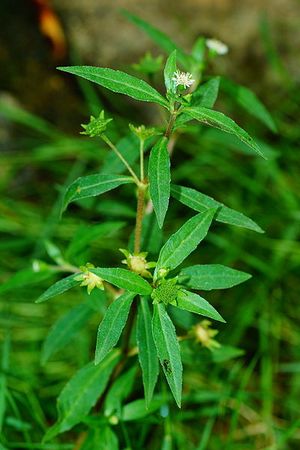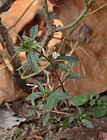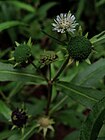Note: This is a project under development. The articles on this wiki are just being initiated and broadly incomplete. You can Help creating new pages.
Difference between revisions of "Eclipta prostrata - Bhrngaraja"
(→Commonly seen growing in areas) |
|||
| (32 intermediate revisions by 2 users not shown) | |||
| Line 1: | Line 1: | ||
| − | [[File:400px-Eclipta prostrata 04791.jpg|thumb|right|'' | + | [[File:400px-Eclipta prostrata 04791.jpg|thumb|right|''Bhrngraja'']] |
| − | + | '''Eclipta prostrata''' is a species of plant in the sunflower family. It is widespread across much of the world. It is widely distributed throughout '''India''', '''Nepal'''. This plant is belongs to Asteraceae family.<ref name="Plant family"/> | |
| − | '''Eclipta prostrata''' | ||
| − | |||
==Uses== | ==Uses== | ||
| − | {{Uses|Loss of appetite}}, {{Uses|Asthma}}, {{Uses|Productive cough}}, {{Uses|Hyperlipidemia}}, {{Uses|Mild | + | {{Uses|Loss of appetite}}, {{Uses|Asthma}}, {{Uses|Productive cough}}, {{Uses|Hyperlipidemia}}, {{Uses|Mild hypertension}}, {{Uses|Intestinal worm}}, {{Uses|Jaundice}}, {{Uses|Piles}}, {{Uses|Abdominal pain}}, {{Uses|Hairfall}}, {{Uses|Preature greying of hair}}, {{Uses|Lucoderma}}. |
==Parts Used== | ==Parts Used== | ||
| − | {{Parts Used| | + | {{Parts Used|Young shoots}}, {{Parts Used|Leaves}}. |
==Chemical Composition== | ==Chemical Composition== | ||
| − | Wedelolactone, Luteolin, Apigenin, Triterpenoids – Eclalbatin, alpha-amyrin, oleanolic acid, ursolic acid, Flavonoids – apigenin and luteolin, Wedelolactone,Echinocystic acid glycosides, β-Sitosterol, Daucosterol <ref name="chemical composition"/> | + | Wedelolactone, Luteolin, Apigenin, Triterpenoids – Eclalbatin, alpha-amyrin, oleanolic acid, ursolic acid, Flavonoids – apigenin and luteolin, Wedelolactone,Echinocystic acid glycosides, β-Sitosterol, Daucosterol.<ref name="chemical composition"/> |
==Common names== | ==Common names== | ||
| − | {{Common names|kn=Ajagara|ml=Kannunni|sa= | + | {{Common names|kn=Ajagara|ml=Kannunni|sa=Bhrngaraja|ta=Karisilanganni, Kavanthakara|te=Galagara|hi=Bhrngaraj, Kesharaj|en=False Daisy, Trailing eclipta}} |
| + | |||
| + | ==Properties== | ||
| + | Reference: Dravya - Substance, Rasa - Taste, Guna - Qualities, Veerya - Potency, Vipaka - Post-digesion effect, Karma - Pharmacological activity, Prabhava - Therepeutics. | ||
| + | ===Dravya=== | ||
| + | |||
| + | ===Rasa=== | ||
| + | Tikta (Bitter), Katu (Pungent) | ||
| + | ===Guna=== | ||
| + | Laghu (Light), Ruksha (Dry) | ||
| + | ===Veerya=== | ||
| + | Ushna (Hot) | ||
| + | ===Vipaka=== | ||
| + | Katu (Pungent) | ||
| + | ===Karma=== | ||
| + | |||
| + | ===Prabhava=== | ||
==Habit== | ==Habit== | ||
| Line 20: | Line 34: | ||
==Identification== | ==Identification== | ||
===Leaf=== | ===Leaf=== | ||
| − | {{Leaf| | + | {{Leaf|Simple|Lanceolate|Leaf Apex is Acute, Leaf Base is Cuneate and Leaf Margin is Serrate-dentate.}}.<ref name="Leaf"/> |
===Flower=== | ===Flower=== | ||
| − | {{Flower| | + | {{Flower|Bisexual|2.5 cm long|White|5-20|In axillary or terminal 1-3 capitula; white. Flowering from December-May}} |
===Fruit=== | ===Fruit=== | ||
| − | {{Fruit| | + | {{Fruit|Oblong achene||An oblong achene, 3-quetrous, hairy above. Fruiting January onwards||}} |
===Other features=== | ===Other features=== | ||
==List of Ayurvedic medicine in which the herb is used== | ==List of Ayurvedic medicine in which the herb is used== | ||
| − | * [[ | + | * [[Bhringamalakadi taila]] |
| + | * [[Bhringarajasavam]] | ||
| + | * [[Manjishtadi kwath]] | ||
| + | <ref name="Ayurvedic preparations"/> | ||
==Where to get the saplings== | ==Where to get the saplings== | ||
==Mode of Propagation== | ==Mode of Propagation== | ||
| − | {{Propagation|Seeds}} | + | {{Propagation|Seeds}}, {{Propagation|Cuttings}} |
==How to plant/cultivate== | ==How to plant/cultivate== | ||
| − | + | Can be raised both from seed as well as stem cuttings. Seed is preferred for raising plantation. Seed germination is 75-85% when freshly collected mature seeds are sown in a well prepared nursery.<ref name="How to plant/cultivate"/> | |
==Commonly seen growing in areas== | ==Commonly seen growing in areas== | ||
| − | {{Commonly seen| | + | {{Commonly seen|Poorly drained area}}, {{Commonly seen|Wet areas}}. |
==Photo Gallery== | ==Photo Gallery== | ||
<gallery class="left" caption="" widths="140px" heights="140px"> | <gallery class="left" caption="" widths="140px" heights="140px"> | ||
| − | File: | + | File:Eclipta prostrata 6.JPG|Whole herb |
| − | File: | + | File:Eclipta prostrata (6968967839).jpg|Flower |
| − | + | File:Eclipta prostrata 5.JPG|At field | |
| − | + | File:Eclipta prostrata - False daisy.jpg|Buds | |
| − | </gallery> | + | File:¿ Eclipta prostrata ? (5597595941).jpg|Leaves |
| + | </gallery>v | ||
==References== | ==References== | ||
| + | <references> | ||
| + | <ref name="chemical composition">[https://www.ayurtimes.com/bhringraj-eclipta-prostrata/ "chemical composition"]</ref> | ||
| + | <ref name="Leaf">[https://indiabiodiversity.org/species/show/229618 "morphology"]</ref> | ||
| + | <ref name="Ayurvedic preparations">[https://easyayurveda.com/2013/09/16/bhringraj-eclipta-alba-benefits-usage-dose-side-effects/ "Ayurvedic preparations"]</ref> | ||
| + | <ref name="How to plant/cultivate">[http://vikaspedia.in/agriculture/crop-production/package-of-practices/medicinal-and-aromatic-plants/eclipta-alba-1 "Cultivation Details"]</ref> | ||
| − | + | <ref name="Plant family">Karnataka Aushadhiya Sasyagalu By Dr.Maagadi R Gurudeva, Page no:117</ref> | |
| − | |||
| − | <ref name=" | ||
| − | |||
</references> | </references> | ||
==External Links== | ==External Links== | ||
| − | + | * [https://www.cabi.org/isc/datasheet/20395 Eclipta prostrata on Invasive Species Compendium] | |
| − | + | * [http://www.flowersofindia.net/catalog/slides/False%20Daisy.html on flowers of india] | |
| + | * [http://naturalhomeremedies.co/Eprostrata.html natural home remedy] | ||
| + | * [https://www.hairlossrevolution.com/eclipta-alba-regrowth-study/ Eclipta Alba for Hair Loss] | ||
[[Category:Herbs]] | [[Category:Herbs]] | ||
| + | [[Category:Asteraceae]] | ||
Latest revision as of 15:08, 7 August 2020
Eclipta prostrata is a species of plant in the sunflower family. It is widespread across much of the world. It is widely distributed throughout India, Nepal. This plant is belongs to Asteraceae family.[1]
Contents
- 1 Uses
- 2 Parts Used
- 3 Chemical Composition
- 4 Common names
- 5 Properties
- 6 Habit
- 7 Identification
- 8 List of Ayurvedic medicine in which the herb is used
- 9 Where to get the saplings
- 10 Mode of Propagation
- 11 How to plant/cultivate
- 12 Commonly seen growing in areas
- 13 Photo Gallery
- 14 References
- 15 External Links
Uses
Loss of appetite, Asthma, Productive cough, Hyperlipidemia, Mild hypertension, Intestinal worm, Jaundice, Piles, Abdominal pain, Hairfall, Preature greying of hair, Lucoderma.
Parts Used
Chemical Composition
Wedelolactone, Luteolin, Apigenin, Triterpenoids – Eclalbatin, alpha-amyrin, oleanolic acid, ursolic acid, Flavonoids – apigenin and luteolin, Wedelolactone,Echinocystic acid glycosides, β-Sitosterol, Daucosterol.[2]
Common names
| Language | Common name |
|---|---|
| Kannada | Ajagara |
| Hindi | Bhrngaraj, Kesharaj |
| Malayalam | Kannunni |
| Tamil | Karisilanganni, Kavanthakara |
| Telugu | Galagara |
| Marathi | NA |
| Gujarathi | NA |
| Punjabi | NA |
| Kashmiri | NA |
| Sanskrit | Bhrngaraja |
| English | False Daisy, Trailing eclipta |
Properties
Reference: Dravya - Substance, Rasa - Taste, Guna - Qualities, Veerya - Potency, Vipaka - Post-digesion effect, Karma - Pharmacological activity, Prabhava - Therepeutics.
Dravya
Rasa
Tikta (Bitter), Katu (Pungent)
Guna
Laghu (Light), Ruksha (Dry)
Veerya
Ushna (Hot)
Vipaka
Katu (Pungent)
Karma
Prabhava
Habit
Identification
Leaf
| Kind | Shape | Feature |
|---|---|---|
| Simple | Lanceolate | Leaf Apex is Acute, Leaf Base is Cuneate and Leaf Margin is Serrate-dentate. |
.[3]
Flower
| Type | Size | Color and composition | Stamen | More information |
|---|---|---|---|---|
| Bisexual | 2.5 cm long | White | 5-20 | In axillary or terminal 1-3 capitula; white. Flowering from December-May |
Fruit
| Type | Size | Mass | Appearance | Seeds | More information |
|---|---|---|---|---|---|
| Oblong achene | An oblong achene, 3-quetrous, hairy above. Fruiting January onwards | {{{6}}} |
Other features
List of Ayurvedic medicine in which the herb is used
Where to get the saplings
Mode of Propagation
How to plant/cultivate
Can be raised both from seed as well as stem cuttings. Seed is preferred for raising plantation. Seed germination is 75-85% when freshly collected mature seeds are sown in a well prepared nursery.[5]
Commonly seen growing in areas
Poorly drained area, Wet areas.
Photo Gallery
v
References
- ↑ Karnataka Aushadhiya Sasyagalu By Dr.Maagadi R Gurudeva, Page no:117
- ↑ "chemical composition"
- ↑ "morphology"
- ↑ "Ayurvedic preparations"
- ↑ "Cultivation Details"
External Links
- Ayurvedic Herbs known to be helpful to treat Loss of appetite
- Ayurvedic Herbs known to be helpful to treat Asthma
- Ayurvedic Herbs known to be helpful to treat Productive cough
- Ayurvedic Herbs known to be helpful to treat Hyperlipidemia
- Ayurvedic Herbs known to be helpful to treat Mild hypertension
- Ayurvedic Herbs known to be helpful to treat Intestinal worm
- Ayurvedic Herbs known to be helpful to treat Jaundice
- Ayurvedic Herbs known to be helpful to treat Piles
- Ayurvedic Herbs known to be helpful to treat Abdominal pain
- Ayurvedic Herbs known to be helpful to treat Hairfall
- Ayurvedic Herbs known to be helpful to treat Preature greying of hair
- Ayurvedic Herbs known to be helpful to treat Lucoderma
- Herbs with Young shoots used in medicine
- Herbs with Leaves used in medicine
- Herbs with common name in Kannada
- Herbs with common name in Hindi
- Herbs with common name in Malayalam
- Herbs with common name in Tamil
- Herbs with common name in Telugu
- Herbs with common name in Sanskrit
- Herbs with common name in English
- Habit - Annual plant
- Index of Plants which can be propagated by Seeds
- Index of Plants which can be propagated by Cuttings
- Herbs that are commonly seen in the region of Poorly drained area
- Herbs that are commonly seen in the region of Wet areas
- Herbs
- Asteraceae





